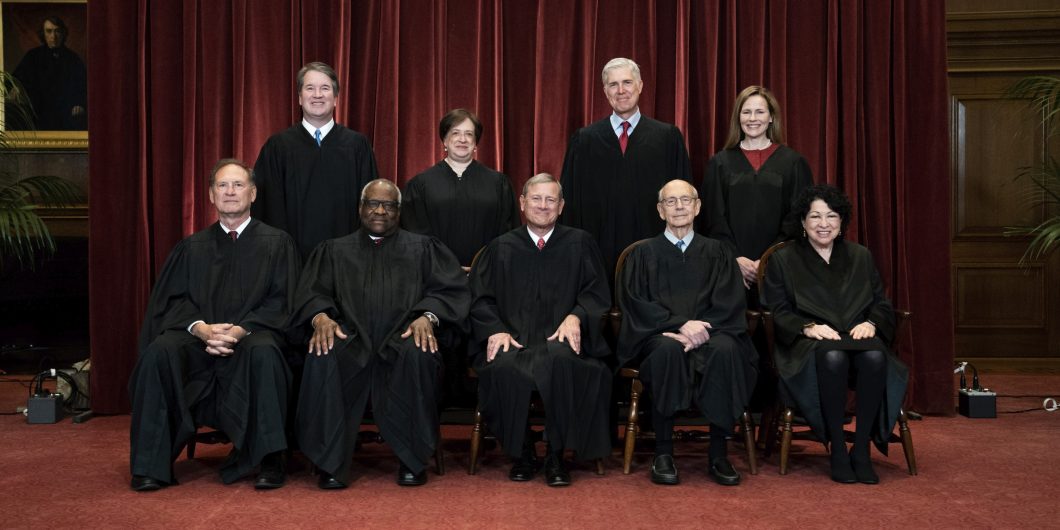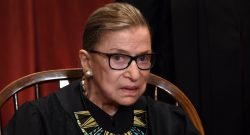Originalism Tested
This term at the Supreme Court promises to be the most substantial test of originalism since its reemergence as a constitutional jurisprudence in the latter part of the last century. For the first time, originalists form a majority on the Court. Justices Thomas, Gorsuch, and Barrett are long-time originalists. Justice Alito has recently declared himself an originalist, and Justice Kavanaugh has strong originalist tendencies.
Yet as the originalist band of justices has grown, so too have the attacks on originalism. During Barrett’s confirmation, Senator Markey labeled it “racist, sexist, and homophobic.” And this slur is not idle chatter. Many senators and commentators advocate court packing that would deprive originalists of a working majority. And, likely in reaction to such political assaults, polls show that the Court has lost support, although it remains more popular than the other branches of government.
The strength of originalism inside the Court and the marshaling of opposition outside its walls would make for drama at any time. But this term features at least three controversial cases—all to be argued before the end of 2021—where originalism should be decisive. The term’s central question is thus whether the Court majority can interpret the law as written even as others press for the law’s distortion.
The Second Amendment
The test of originalism begins today, when the Court hears arguments in New York State Rifle and Pistol Association v. Bruen. There the petitioners are challenging a New York state statute that restricts the carrying of guns outside the home to those whom New York in its discretion accepts as having a “special need to do so.” In Heller v. District of Columbia and McDonald v. Chicago, the Court has already decided that the Second Amendment protects the individual’s right to keep a gun at home against both state and federal prohibitions. The question in this case is whether and to what extent the Second Amendment also protects the right to carry a gun outside the home.
The originalist argument for that right is strong. The two previous Second Amendment cases provided strong evidence that the Second Amendment protects an individual right and applies generally, not only to those in a militia. Since those decisions, commentators have added additional evidence for the individual rights interpretation of the Second Amendment—in my case from James Madison’s own reflection on the Bill of Rights.
Once those matters are settled, as they now have been twice at the Court, the only remaining question is whether the New York statute is consistent with the individual right to bear arms. On its face, it is not. The New York law prohibits the vast majority from bearing arms, permitting the activity as a privilege for a select few. If it were to be upheld, the Second Amendment would become a right unlike any other in the Constitution—one that can be restricted to those chosen by the government.
New York State’s unlimited discretion cannot be analogized to time, place, and manner restrictions that are accepted parts of regulating other rights, like the First Amendment. Nor can it be justified by any argument that the individual is likely to misuse the right, like a restriction on felons, as is the case in voting restrictions. Instead, New York has reversed the basic presumption of rights—that people should be equal in their capacity to enjoy them against state interference.
Defenders of the New York State statute have argued that there were similar laws in England and in the northern states that restricted the right to carry arms outside the home. But, as Nelson Lund and Robert Leider have ably shown in their amicus brief, these statutes were aimed at a subclass of arms-bearing outside the home—carrying that was intended to terrorize people or breach the peace. They thus were narrow exceptions based on misuse of the right, not wholesale restrictions on its exercise.
Thus, the hard question in this case is not whether the statute should be upheld but whether an originalist court will have the courage to strike it down. Heller and McDonald did not take as much courage, because only a handful of jurisdictions prohibited the holding of guns inside the home and because such a restriction was nationally so unpopular. More jurisdictions heavily regulate carrying outside the home. Previously, the Court has symbolically vindicated the original meaning of the Constitution, as when it invalidated the Gun-Free Schools Act as beyond Congress’s power under the Commerce Clause, only to pull back when it came to more consequential statutes, like drug laws, in Gonzales v. Raich. But with many more thoroughgoing originalists on the Court today, I remain optimistic that the Second Amendment will not be relegated to mere symbolism.
The Free Exercise Clause
Perhaps the most important case for the long-term health of the nation is Carson v. Makin. In that case, Maine gave tuition assistance to parents in areas without public schools so that their children can attend private schools. But Maine also restricted the use of this assistance to attending schools that are not “sectarian.” Thus, students can attend secular private schools or even schools associated with a religious institution, but not schools where, in the judgment of the state officials, the instruction is too religiously oriented.
Previously, the Supreme Court has held that a state cannot discriminate in providing funds to parents based on the religious “status” of schools. The question here is whether the states can discriminate based on the religious content of the education they deliver. Like the Second Amendment, the meaning of the words of the Constitution is telling. They show that the state cannot so discriminate. The First Amendment, which has been incorporated by the Fourteenth Amendment against the states, provides that the state will not interfere with the “free exercise of religion.” The exercise of religion involves conduct, including teaching one’s children in a manner consistent with one’s faith. Thus, as with other constitutional rights, a decision by the state to condition financial assistance on the surrender of the right is illegal.
If opinions in all three of these cases move toward vindicating the original meaning of the Constitution, this term will mark a decisive turn toward a law of right reason.
And, as Michael McConnell shows in his excellent amicus brief, a contrary result would favor some religions over others. The reason that schools associated with some churches, like mainline Protestant denominations, qualify for funding in Maine is that their teaching can be presented as sufficiently vague and secular as to seem anodyne. But the Free Exercise Clause historically protected insurgent churches with doctrines that might strike outsiders as excessively hard-edged.
A decision for parents who want to choose religiously oriented schools will have long-term beneficial effects. It should energize religious organizations to join others who are concerned about public schools because of their low quality and/or ideological indoctrination to lobby for school vouchers and tuition assistance, confident that they cannot be excluded from a program simply because of religious content in their curriculum. More competition from secular and religious private schools in K-12 education will in turn both increase human capital and foster the diversity of views about human flourishing that is the foundation of a pluralist, liberal society.
Abortion
The most discussed case of the term, Dobbs v. Jackson Women’s Health Organization, also tests originalism. In Dobbs, Mississippi has imposed a fifteen-week limit on abortions, which is more stringent than the trimester limit decreed in Roe and ratified in Casey. On the substance, there can be little doubt that Roe and Casey are nonoriginalist, even anti-originalist opinions. The only plausible place to locate substantive constraints on state abortion legislation is the Privileges or Immunities Clause of the Fourteenth Amendment. But on any of three possible originalist interpretations of that provision (besides the one that would view it as limited to incorporating the Bill of Rights), it cannot be understood to include a right to abortion. Some think the Privileges or Immunities Clause should include the largely economic rights of an antebellum case, Corfield v. Coryell, that had previously defined the words, but abortion is not an economic right. Others think that the Clause should protect any rights on which there was a consensus in the states at the time of the Fourteenth Amendment, but there was no consensus then in favor of abortion rights. Even if one thought (in my view wrongly) that the Clause is dynamic and protects rights on which there is consensus among states today, abortion rights still fail to command the requisite consensus.
The harder question for originalists is posed by the question of precedent. Unlike the Second Amendment and Free Exercise cases this term, the sound originalist result in Dobbs conflicts with precedent squarely. Few of the justices, other than Clarence Thomas, have articulated a principled position on the relationship between originalism and precedent. In my view, the precedent rules should not ultimately insulate the Court’s abortion jurisprudence. Any substantial reliance interests could be protected by staying the Court’s overruling of Roe for three months.
Another possible approach would be not to overrule Roe entirely but cut it back so as to uphold the Mississippi statute. It may seem prudent to move toward the original meaning but go no farther than what is required to decide the case. The justices could argue that a rational restructuring of current doctrine also supports that result. Casey’s core requirement that states not place an undue burden on abortions is in fact satisfied by giving a fifteen-week window for seeking abortions. Roe’s additional requirement—reiterated in Casey, but not pivotal to the decision in the case—that the right to abortion be protected until viability is not necessary to give women a reasonable opportunity to terminate their pregnancy. But regardless of whether Dobbs overrules Roe entirely or cuts it back, the decision will likely shift abortion jurisprudence closer to the original meaning.
If opinions in all three of these cases move toward vindicating the original meaning of the Constitution, this term will mark a decisive turn toward a law of right reason.


